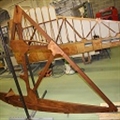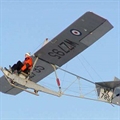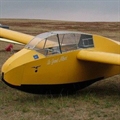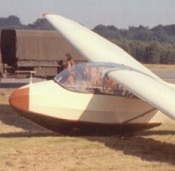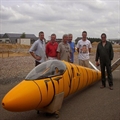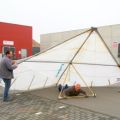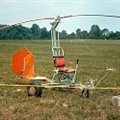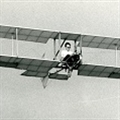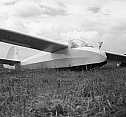Collection - Gliders
Glider: T3 Dagling (Zogling)
Manufacturer: Slingsby Aviation
Registration: -
Status: In restoration at workshop
Manufacturer: Slingsby Aviation
Registration: -
Status: In restoration at workshop
The Zogling primary glider was designed mid twenties by Fritz Stamer and Alexander Lippisch who worked together at the Aeronautical Department of the Rhön-Rossitten Gesellschaft (RRG).
Drawings were spread in USA and England where Reginald Dagnall led his company RFD of airship building.
Drawings were spread in USA and England where Reginald Dagnall led his company RFD of airship building.
Glider: T38 Grasshopper
Manufacturer: Slingsby Aviation
Registration: -
Status: In restoration at workshop
Manufacturer: Slingsby Aviation
Registration: -
Status: In restoration at workshop
The Slingsby T.38 Grasshopper is a British primary training glider built by Slingsby Sailplanes for the Royal Air Force. The design is based on the pre-World War II German SG 38 Schulgleiter, modified to use the wing design of the Slingsby T.7 Kirby Cadet glider. The design was cheap to manufacture and was designed to be stored dismantled.
Glider: MU-13E Bergfalke
Manufacturer: Egon Scheibe
Registration: OO-ZLM
Status: stored at workshop, good condition
Manufacturer: Egon Scheibe
Registration: OO-ZLM
Status: stored at workshop, good condition
The MU-13 is a german glider produced in several versions by Akaflieg München before WWII.
First flown on 5 august 1951, it is a mid-wing glider of conventional design with a welded steel fuselage structure and a wooden wing.
First flown on 5 august 1951, it is a mid-wing glider of conventional design with a welded steel fuselage structure and a wooden wing.
Glider: Schleicher KA-4 Rhönlerche II
Manufacturer: Schleicher
Registration: OO-ZUP
Status: stored at workshop, restoration required
Manufacturer: Schleicher
Registration: OO-ZUP
Status: stored at workshop, restoration required
The Rhönlerche is a tamdem two-seater training sailplane. It is the first design of Rudolf Kaiser for the company Schleicher which is one of the oldest sailplanes manufacturer in the world.
The goals were to produce a simple, inexpensive and robust two-seat trainer for school and club use.
The goals were to produce a simple, inexpensive and robust two-seat trainer for school and club use.
Glider: SH1 Austria s/n 55
Manufacturer: Schempp-Hirth
Registration: OO-ZTL
Status: stored at workshop, good condition
Manufacturer: Schempp-Hirth
Registration: OO-ZTL
Status: stored at workshop, good condition
The Austria glider was commissioned by the Österreichischer Aeroclub to compete in the 1960 OSTIV competition for a Standard class sailplane.
The design aims were to produce a glider with a low wing loading and a high lift/drag ratio.
The design aims were to produce a glider with a low wing loading and a high lift/drag ratio.
Glider: Bölkow Phoebus
Manufacturer: Bölkow gmbh
Registration: OO-ZDX
Status: stored at workshop, good condition
Manufacturer: Bölkow gmbh
Registration: OO-ZDX
Status: stored at workshop, good condition
The Phoebus was designed at a time when glider manufacturers were moving away from all-wood aircraft towards composite structure.
It is a glass fibre competition sailplane in the Standard class produced in Germany mid-sixties.
It is a glass fibre competition sailplane in the Standard class produced in Germany mid-sixties.
Glider: SSVV Ciani EC39 Uribel B
Manufacturer: SSVV
Registration: OO-ZXZ
Status: displayed at the workshop
Manufacturer: SSVV
Registration: OO-ZXZ
Status: displayed at the workshop
The SSVV (ezione Sperimentale Volo Vela) was created by the Milan flying club to maintain the club's gliders and to design new models, the Uribel B being one of those.
OO-ZXZ was based in Weeldeand will fly until January 1981 when it is crashed in Keiheuvel
OO-ZXZ was based in Weeldeand will fly until January 1981 when it is crashed in Keiheuvel
Glider: Planair Delta Wing
Manufacturer: Planair
Registration:
Status: stored at the workshop
Manufacturer: Planair
Registration:
Status: stored at the workshop
Given by the aeroclub of Buzet, we have no information about this "Planair" delta wing We only found the inscriptions "Planair", the letters STP and a sticker from the Ator Delta club in Rixensart.
Any information is therefore welcome!
Any information is therefore welcome!
Glider: B-8 Gyro Glider
Manufacturer: Bensen Aircraft Corporation
Registration: -
Status: displayed at workshop
Manufacturer: Bensen Aircraft Corporation
Registration: -
Status: displayed at workshop
In 1954, Igor Bensen designed the Gyroglider as a means to introduce aviation enthusiasts to the thrills of flight with minimal cost. The pilot relied on an automobile to pull the aircraft aloft. The movement of air through the rotor disc caused the blades to autorotate, which provided lift.
Glider: Sablier Type 8 Sport Chanute
Manufacturer: Thibaut Camermans
Registration: -
Status: under construction at workshop
Manufacturer: Thibaut Camermans
Registration: -
Status: under construction at workshop
Georges Sablier was a french engineer who designed an unbelievable number of gliders and light aircrafts intended for air enthusiasts. He never built them himself but his works were published in books and many magazines.
Glider: Max Williams 29 Jeunesse
Manufacturer: Daniel Pletinckx
Registration: -
Status: In restoration at workshop
Manufacturer: Daniel Pletinckx
Registration: -
Status: In restoration at workshop
The « Jeunesse » is originally a hang-glider that could be easily be built by any aviation amateur.
The B.A.P.A. example was built by Daniel Pletinckx who modified the « Jeunesse » with a seated position for the pilot and the possibility to fit a small engine on the nose. This one was never fitted.
The B.A.P.A. example was built by Daniel Pletinckx who modified the « Jeunesse » with a seated position for the pilot and the possibility to fit a small engine on the nose. This one was never fitted.
Glider: Scheibe Spatz A
Manufacturer: Scheibe Flugzeugbau
Registration: OO-ZVW
Status:cockpit display.
Manufacturer: Scheibe Flugzeugbau
Registration: OO-ZVW
Status:cockpit display.
The Scheibe Spatz (sparrow) is a single-seat German glider built from 1952 to 1962 by Scheibe Flugzeugbau in Germany. The cockpit on display is no. 268, built in 1959 and registered as OO-ZVW on June 9, 1965. It was de-registered on December 21, 1971. BAPA owns another complete Spatz A

